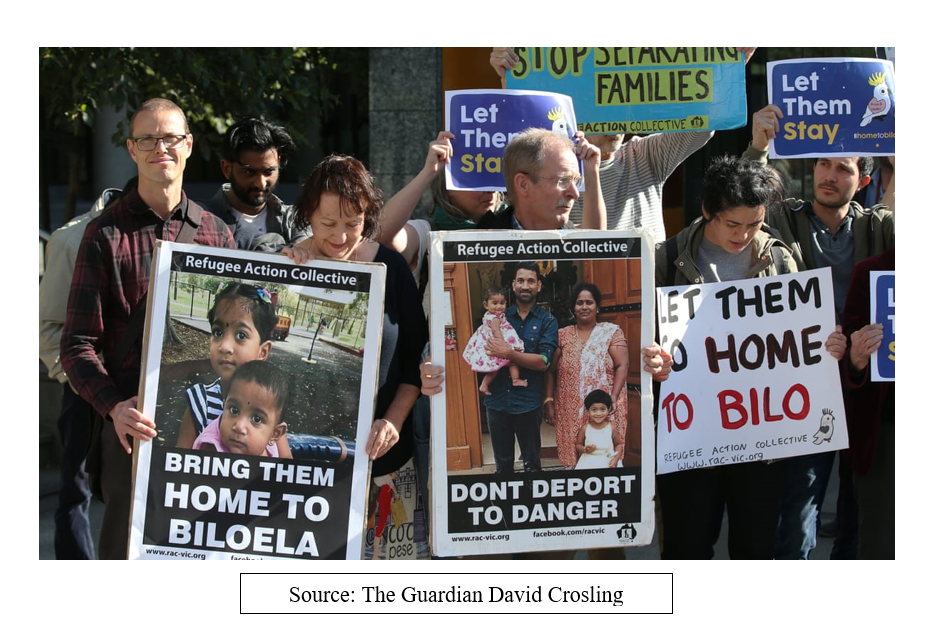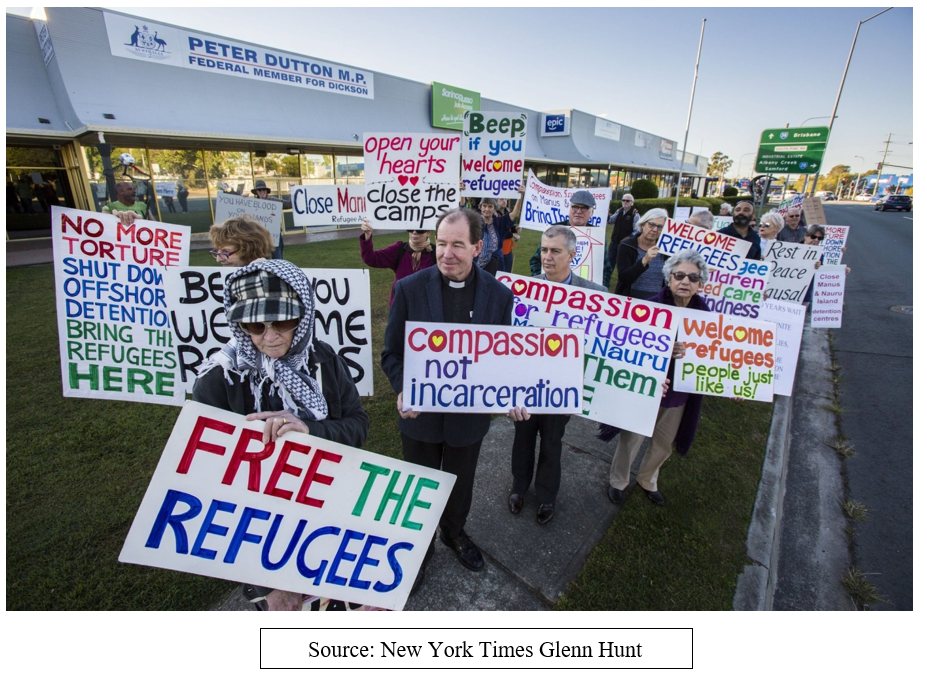By Gopika Aryad
Deprivation of liberty means ‘any form of detention or imprisonment, or the placement of a person in another public or private custodial setting from which this person is not permitted to leave at will, by order of any judicial, administrative or other public authority’.[1] The UN Human Rights Committee has reported on several occasions that the immigration detention policies of the Australian Government breach human rights.[2]
There are currently less than 5 children in Immigration Residential Housing, Immigration Transit Accommodation and Alternative Places of Detention, and 181 children are living in the community after being approved for a residence determination.[3] But despite this, heartbreaking images have emerged of two young girls, Tharunicaa and Kopika, who have spent three years in an Australian immigration detention centre.[4] They, along with their parents, are Tamil asylum seekers who were taken from their home on the 5th of March 2018 after overstaying their visa.[5] They are the only family detained on Christmas Island waiting for their decision amidst the pandemic.[6] The Government has spent $1.4 million in the past year to keep this family on the island.[7] Yet, it has been three years since the young children have seen the outside world; nothing could justify the lost years of their childhood.
I VIOLATION OF CHILD RIGHTS IN THE DETENTION CENTRES
Every child has a set of rights recognised under the Convention on the Rights of the Child (CRC), to which Australia is a signatory. The CRC mandates that detention should not be arbitrary.[8] To avoid it being arbitrary, such detention must be necessary, reasonable, and a proportionate means of achieving a legitimate aim.[9] In light of these provisions, the Migration Act 1958 (Cth) was amended in 2005 to reflect such principles of the CRC to ensure that minors were detained only as a last resort.[10] However, contrary to these obligations and statutory provisions, the Australian Government utilises detention as a first action, even in the case of children. [11] This is exemplified in the present case of the young girls.
Furthermore, detention must always be the shortest period of time for a child.[12] Since the length of time in detention is proportionate to the time of resolution of their visa status, processing therefore must be prompt in the case of children in detention. The United Nations’ guidelines on the detention of refugees mandate prescribing limits on the detention period via statutory provisions.[13] Such guidelines have not been followed in Australia; and yet, compliance could save innocent children from spending years in detention centres.
Additionally, The National Inquiry into Children in Immigration Detention recommended the review process be conducted by an independent body within 72 hours of a child being in detention.[14] However, despite these recommendations, no implementation or process of implementation has occurred.
Under the CRC, decision makers must always consider the ‘best interests’ of the child.[15] The Australian Governments over the years have chosen to argue that it would be in the ‘best interests’ of the children to be detained along with their parents.[16] But why would those with bridging visas, which yield no right to travel or even work, have to be in detention in the first place? The Ministry of Home Affairs have numerous mechanisms to track these individuals if any violation of visa conditions occurs. Moreover, there is no evidence that the family’s presence in the community would hamper the processing of their protection visa, or any Australian community standards. Despite this, they continue to lead their life isolated on an island along with their young children.
The Commonwealth governments over the years have asserted their position that the mandatory detention of children does not contravene the CRC as such detention is required for ‘legitimate, non-punitive and proportionate reasons’.[17] It is difficult to answer as to what legitimate purpose the Government is fulfilling in keeping these young children away from society for over three years.
II IMPACT OF DETENTION ON CHILDREN
The CRC mandates that every child in Australia, irrespective of their nationality, immigration status, or how the child arrived in the country, survives and develops to the maximum extent possible;[18] enjoys the highest attainable standard of health and rehabilitation;[19] and is allowed to recover from abuse or violence.[20] The 2014 report by the Australian Human Rights Commission (AHRC) highlighted that prolonged detention of children has serious ramifications on their mental and emotional health and development.[21]
The statements from Tharunicaa and Kopika’s mother, Priya, reveal the difficulties of explaining the current situation to her children and the impact of the current situation itself. “Recently she started telling us that her friends are asking why she is always accompanied by guards to school when they are taken to school by their parents.” Priya had stated.[22] “When she goes to school, she is very happy but when she comes home, she’s really unhappy. She wants to go shopping. She’s really unhappy being in this detention centre.”[23]
The impact of not being allowed to see friends, or to go out to places like the shops or parks, during these pivotal periods of development can be detrimental. Children do not develop in isolation, but in response to their environment and the nurture of their family and community. Given the various levels of uprooting, disruption and insecurity involved in the refugee experience, the development of these two children is likely to be severely hindered.[24] In fact, Kerryn Phelps AM, MP, an active advocate for the release of Priya’s family, has opined that the environment in detention centres can yield increased rates of early depression, distress, anxiety and impairment of social development.[25]
Additionally, there have been increasing concerns over the living conditions within these detention centres. Priya has reported that her family has been sharing a bed in a room that leaks when it rains and is “infested with centipedes”.[26] Though there has not been any official clarification regarding these claims, there is no doubt that these children would require professional assistance in integrating into society.
III CURRENT DEVELOPMENTS IN THEIR ASYLUM CLAIM
In 2020, the Federal Court ruled that Tharunicaa was denied "procedural fairness" as the family was not invited to comment in relation to their assessment for protection visa before the Minister made the decision, thus ordered the Commonwealth to pay legal costs of more than $200,000. The Federal Government appealed to the full bench of the Federal Court and in February 2021, the full bench ruled that the original ruling stands.[27] A separate appeal brought by the family against the detention was rejected. Though the amount awarded would cover the existing and possible future legal costs, the family still must be in detention. The family’s solicitor, Carina Ford, is currently considering the option to approach the High Court after seeking special leave, and plans to file an injunction to remove the family from detention.[28] However, the Department of Home Affairs has made it clear that the family has failed to prove the grounds for protection in the Migration Act 1958 and that the Government’s policy is to ensure that no illegal maritime travel with an attempt to settle in Australia is encouraged.[29]
Recently, Senator Keneally visited the family on Christmas Island to talk with them and gain a better understanding of their situation. After visiting them she remarked as to how the family was struggling and coping in the detention along with the two young girls. She has urged the Government to intervene and return the family to their adopted home in Queensland.[30] The family hopes and urges the Home Minister to look at their case with ‘fresh eyes’, whilst the Opposition has been pressing the Government to release the family.[31] As Senator Keneally remarks, "These two little girls have been in detention for most of their lives now. This isn't a political issue, it's a human issue."[32]
IV CONCLUSION
Despite all the intricacies of statutory provisions and International Law, the real question remains: how long can we, as a society, allow our Government to detain young children and deprive them of their childhood? The answer is not simply in a change of Government, but rather, in the common consciousness of our representatives in Parliament and their willingness to place humanity over the stricter application of refugee policies. Until these children are released from the detention centre, it is our responsibility to ensure that we continue to raise our voices against this grave injustice.
[1] The United Nations Rules for the Protection of Juveniles Deprived of their Liberty, GA Res 45/113, UN Doc A/RES/45/113 (14 December 1990).
[2] Convention on the Rights of the Child, UN Doc CRC/C/15/Add.79 (10 Oct 1997).
[3] Department of Home Affairs, Immigration Detention and Community Statistics Summary (Report, 28 February 2021).
[4] Maani Truu, ‘These two children have now been in Australian immigration detention for three years’, SBS (online, 4 April 2021) <https://www.sbs.com.au/news/these-two-children-have-now-been-in-australian-immigration-detention-for-three-years> (‘Maani Truu’).
[5] Ibid.
[6] Ibid.
[7] Julian Smith, ‘It’s time to give visas to the Biloela Tamil family and other asylum seekers stuck in the system’, The Conversation (online, 16 February 2021) <https://theconversation.com/its-time-to-give-visas-to-the-biloela-tamil-family-and-other-asylum-seekers-stuck-in-the-system-155354>.
[8] Ibid.
[9] Australian Human Rights Commission, The Forgotten Children-National Inquiry into Children in Immigration Detention (Report, 2014).
[10] Migration Act 1958 (Cth) s 4A.
[11] Human Rights and Equal Opportunity Commission, A last resort? National Inquiry into Children in Immigration Detention (Report, 2004) (‘Human Rights and Equal Opportunity Commission’).
[12] United Nations Conventions on the Rights of the Child, opened for signature 20 November 1989, 1577 UNTS 3 (entered into force 2 September 1990) art 37(b) (‘CRC’).
[13] UN High Commissioner for Refugees (UNHCR), Guidelines on the Applicable Criteria and Standards relating to the Detention of Asylum-Seekers and Alternatives to Detention, 2012.
[14] ‘Human Rights and Equal Opportunity Commission’ n (11) 851.
[15] ‘CRC’ (n12) art 21.
[16] ‘Human Rights and Equal Opportunity Commission’ n (11).
[17] Ibid.
[18] ‘CRC’ (n 12) art 6(2).
[19] Ibid art 24(1).
[20] Ibid art 39.
[21] Australian Human Rights Commission, The Forgotten Children-National Inquiry into Children in Immigration Detention (Report, 2014).
[22] Josh Taylor, ‘1,000 days later: the Biloela family spending their third Christmas in detention, The Guardian (Online, 6 December 2020) <https://www.theguardian.com/australia-news/2020/dec/04/1000-days-later-the-biloela-family-spending-their-third-christmas-in-detention>.
[23] Ibid.
[24] ‘Human Rights and Equal Opportunity Commission’ n (11).
[25] ‘Maani Truu’ n (4).
[26] Ibid.
[27] Ashleigh Stevenson and Rachel McGhee, ‘Tamil family to stay on Christmas Island after Federal Court upholds previous ruling over youngest child's immigration status’, ABC (online, 16 February 2021)
[28] Ibid.
[29] Ibid.
[30]Daniel McCullouch, ‘Struggling and coping: Senator visits Tamil family on Christmas Island’, The New Daily (online, 20 April 2021) https://thenewdaily.com.au/news/2021/04/20/biloela-tamil-kristina-keneally/.
[31] Ibid.
[32] Ibid.



